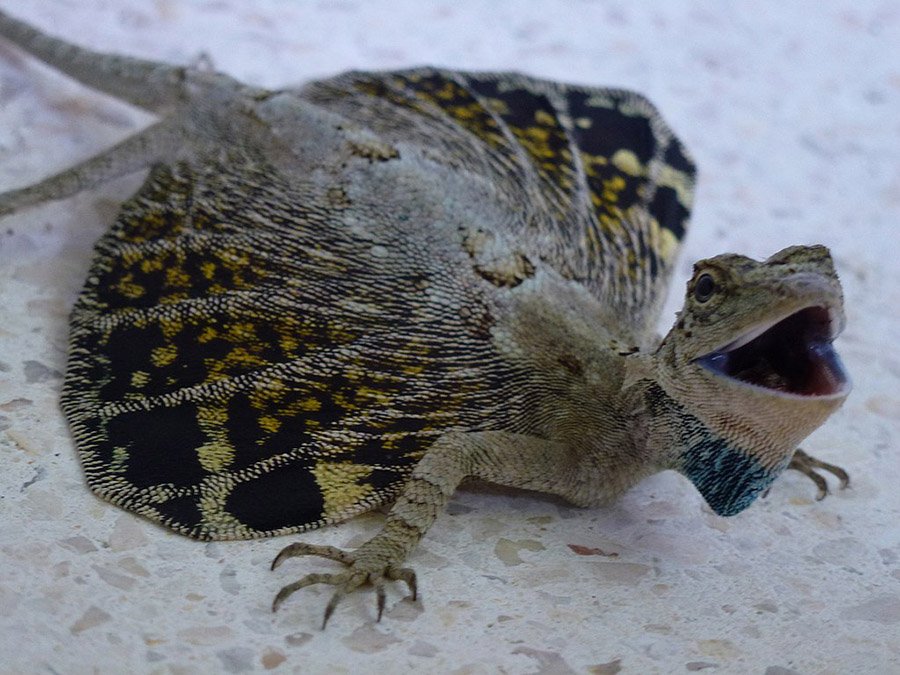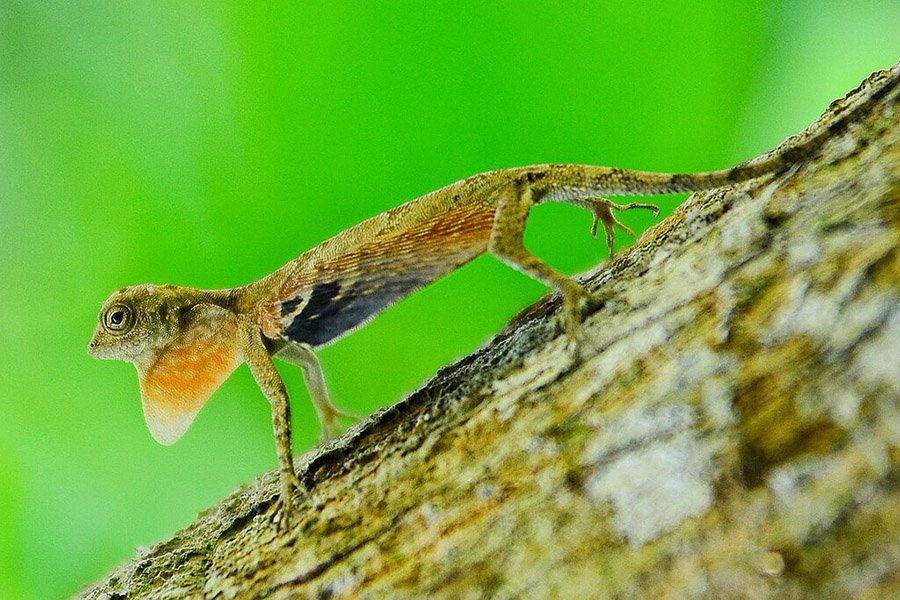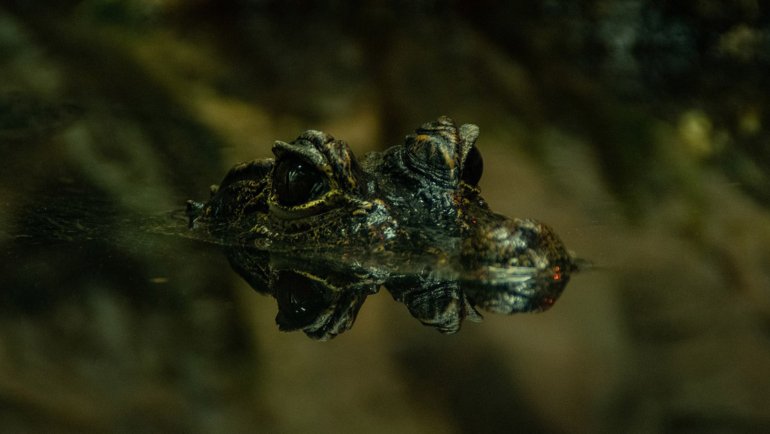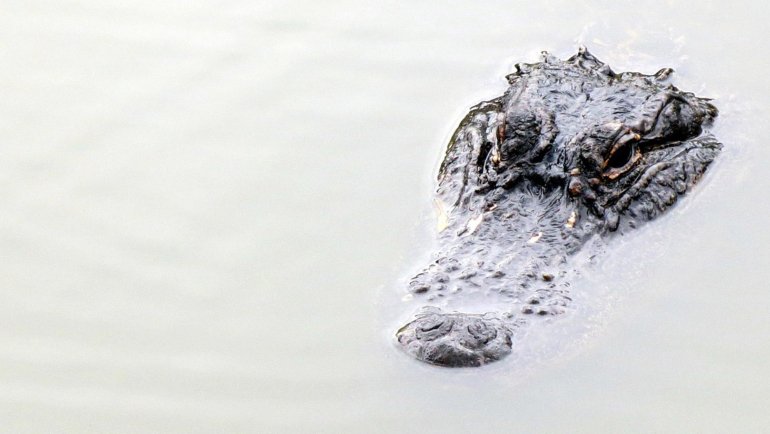The Draco volans, commonly known as the “Flying Dragon,” is a species of lizard renowned for its remarkable ability to glide through the air.
This small, arboreal reptile, found in the tropical forests of Southeast Asia, has captivated the interest of both scientists and the public with its unique adaptation for flight.
This article provides a comprehensive overview of the Draco Volans, from its classification and physical characteristics to its behavior, diet, and conservation status, offering insights into the life of this fascinating creature.
The Common Flying Dragon at a Glance
Classification
| Kingdom: | Animalia |
| Phylum: | Chordata |
| Class: | Reptilia (Reptiles) |
| Order: | Squamata |
| Family: | Agamidae |
| Genus: | Draco |
| Species: | D. volans |
Essential Information
| Average Size: | Length: 8 to 9 inches (20 to 23 cm), including the tail |
| Average Weight: | Approximately 0.5 ounces (15 grams) |
| Average Lifespan: | Around 5-8 years in the wild |
| Geographical Range: | Southeast Asia, primarily in Indonesia, Malaysia, and the Philippines |
| Conservation Status: | Least Concern (IUCN Red List) |
Species and Subspecies
The Flying Dragon is part of the genus Draco, which contains over 40 species of gliding lizards. These species share the characteristic wing-like structures but differ in aspects such as coloration, size, and specific gliding abilities. Here are some species:
- Draco maculatus: Notable for its spotted body, predominantly found in Thailand and Malaysia.
- Draco sumatranus: Larger than Draco Volans, with a more pronounced snout, found in Sumatra.
- Draco cornutus: Known for horn-like structures on its head, native to Borneo.
Each species within the Draco genus has adapted to its specific environment, with variations that allow for more effective gliding, camouflage, or mating displays. Despite these differences, all members of the Draco family exhibit the unique adaptation of extended ribs that enable their gliding capability.
 Source: Wikimedia Commons
Source: Wikimedia CommonsDescription
The Common Flying Dragon (Draco volans) is a small, arboreal lizard known for its remarkable gliding abilities. It possesses unique physical traits that enable it to move through the air with ease.
The most distinctive feature of the Flying Dragon is its “wings,” which are extended ribs covered in skin, known as patagia. These structures can be expanded and retracted, aiding in its gliding ability. Typically, they have a body length of about 8 to 9 inches (20 to 23 cm), including the tail.
Their coloration varies, usually incorporating shades of brown, gray, or green, which provides excellent camouflage among the trees. Some species exhibit bright colors on their patagia, used in displays during mating or territorial disputes.
Males often have larger and more brightly colored patagia than females. They also tend to be slightly larger and may have crests or other distinguishing features.
Habitat and Distribution
The Common Flying Dragon is native to the tropical forests of Southeast Asia, with a distribution that includes Indonesia, Malaysia, and the Philippines. They are primarily found in rainforests and heavily wooded areas.
These lizards favor habitats with abundant trees, as their gliding ability is central to their movement and escape strategies. They are often found in the mid to upper-canopy levels of the forest.
 Source: Wikimedia Commons
Source: Wikimedia CommonsBehavior
The behavior of the Common Flying Dragon reflects its arboreal and gliding lifestyle. They are diurnal, active during the day, and spend most of their time in trees. Their movement on land is less agile, so they prefer to stay aloft.
Flying Dragons are generally solitary, coming together only for mating purposes. They are territorial, with males displaying their patagia to ward off rivals and attract females.
Visual signals, such as extending their patagia, are a key form of communication, especially during mating season. They may also use subtle body movements and positioning to convey messages to other Flying Dragons.
Their gliding is more of a controlled descent than true flight, allowing them to move from tree to tree or escape predators. They can glide distances of up to 60 feet (about 20 meters), although typical glides are shorter.
The lifestyle and behaviors of the Common Flying Dragon are intricately linked to their unique anatomy, allowing them to navigate and thrive in the tree canopies of the tropical forests they inhabit.
Diet and Feeding Behavior
The Common Flying Dragon has a diet that aligns with its arboreal lifestyle. They are insectivorous, feeding mainly on ants, termites, and small beetles. Their diet can vary slightly depending on the availability of insect prey in their habitat.
These lizards typically hunt from the trees, using their excellent camouflage to ambush prey. They may also glide to the ground to forage for insects and return to the trees to consume their catch.
Predators
As a small lizard, the Common Flying Dragon faces several natural predators in its forest habitat. Their main predators include larger birds, snakes, and occasionally larger mammals. Their ability to glide and their camouflaging coloration are key defensive mechanisms against these threats.
When threatened, the Common Flying Dragon will often flatten its body against the tree trunk to remain undetected or will use its gliding ability to escape predators, quickly gliding to another tree.
 Source: Wikimedia Commons
Source: Wikimedia CommonsReproduction and Life Cycle
The reproduction of the Common Flying Dragon involves some distinctive behaviors and characteristics. Mating often involves males displaying their colorful patagia to attract females. Territorial displays between males can also be a part of the breeding ritual.
After mating, the female lays eggs in small clutches, typically in the ground or in tree hollows. The number of eggs per clutch can vary.
There is minimal parental care after the eggs are laid. Once hatched, the young are independent and receive no further care from the parents. They are born with the ability to climb and glide.
The life cycle of the Common Flying Dragon from hatching to adulthood is characterized by rapid growth and development. Young lizards quickly learn to hunt and glide, skills that are crucial for their survival in the forest canopy.
Conservation and Threats
The conservation status of the Common Flying Dragon (Draco volans) can vary depending on the specific region and environmental factors:
As of now, they are not listed as endangered or threatened on a global scale. However, like many forest-dwelling species, they could be vulnerable to habitat loss due to deforestation and climate change.
The primary threat to the Flying Dragon is habitat destruction, particularly the loss of forest habitats in Southeast Asia due to logging, agriculture, and urban development.
Conservation efforts for the Flying Dragon include protecting their natural habitats, enforcing regulations on deforestation, and promoting sustainable land use practices in regions where they are found.
Fun Facts
- Gliding Mechanism: The Flying Dragon’s ability to glide is facilitated by a set of elongated ribs that extend and retract, forming ‘wings’ that allow it to move through the air.
- Mimicking Leaves: When not in flight, the patagia of the Flying Dragon can resemble a leaf, aiding in camouflage among the trees.
- Variety of Species: The genus Draco, to which the Flying Dragon belongs, includes over 40 different species, each with unique adaptations for gliding.
- Territorial Displays: Male Flying Dragons often engage in colorful displays to establish territory and attract mates, showcasing their vibrant patagia.
- Efficient Hunters: Despite their primary mode of transportation being gliding, these lizards are agile and effective hunters, capturing insects with precision.
Frequently Asked Questions
Can the Common Flying Dragon actually fly?
The Common Flying Dragon cannot fly in the same way birds or bats do; instead, it glides from tree to tree using its extendable rib ‘wings’.
How long can a Flying Dragon glide?
Flying Dragons can glide for distances of up to 60 feet (around 20 meters), though typical glides are shorter.
What do Flying Dragons eat?
Their diet mainly consists of small insects like ants, termites, and beetles.
Where can Flying Dragons be found?
They are native to the tropical forests of Southeast Asia, including Indonesia, Malaysia, and the Philippines.
How do Flying Dragons reproduce?
During mating, males display their patagia to attract females. Females lay eggs in the ground or tree hollows, and the young are independent upon hatching.



